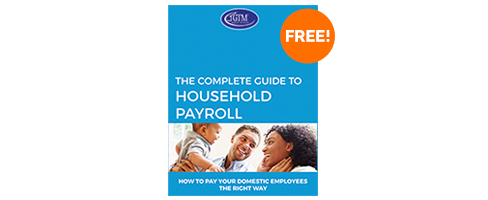
Health Benefits for Nannies and Other Household Employees
Looking for ways to offer health care benefits to your nanny or other household employees? Here are some options to consider that are also affordable and tax-friendly. Offering health benefits is a great way to attract the best talent to your position and retain your top employees.
These health plans are better choices for you and your employee than giving them money or a stipend. Pre-tax plans reduce an employee’s taxable wages lowering your and your worker’s tax obligations. Stipends can be considered taxable income.
GTM Payroll Services can administer a plan for you and tie it into your payroll service to make health care coverage easy for you and your employee. Call (800) 929-9213 with any questions or to get started.
Qualified Small Employer Health Reimbursement Arrangement (QSEHRA)
A QSEHRA allows employers with less than 50 employees to offer a Health Reimbursement Arrangement. It’s a great option for household employers who don’t offer a full health insurance plan for their employees. Under a QSEHRA, employees are reimbursed for health insurance plans purchased on the individual market or through the Affordable Care Act health care exchange. They can also be paired with an employee’s spouse’s plan. A QSEHRA can also be used for out-of-pocket medical, dental, and vision expenses. They are employer-funded and tax-free for your employee.
Annual employer contributions to a QSEHRA are capped at $6,150 for an employee who is single and $12,450 for an employee with a family.
Learn more about offering a QSEHRA.
Individual Coverage Health Reimbursement Arrangement (ICHRA)
An Individual Coverage Health Reimbursement Arrangement (ICHRA) may appeal to household employers who wish to provide tax-free health benefits to their employees.
ICHRAs are like QSEHRAs as they are both employer-funded Health Reimbursement Arrangements (HRAs) that reimburse employees tax-free for health insurance premiums and/or medical expenses. The money contributed by a family to an ICHRA is also not subject to employer taxes.
The major difference between an ICHRA and a QSEHRA is that there are no annual contribution limits with an ICHRA while QSEHRAs are restricted to a set amount each year.
With an ICHRA, employees pay for their individual health insurance premiums and/or medical expenses and then submit receipts for reimbursement from their employer.
Learn more about offering an ICHRA.
Flexible Spending Accounts (FSA)
An FSA can be used for health insurance deductibles and co-payments, prescription medications, over-the-counter medicines with a doctor’s prescription, and medical equipment and supplies.
FSAs are funded by the employee with up to $3,200 in pre-tax dollars used to cover qualified expenses. Employers can make contributions to their employee’s FSA but aren’t required to.
Since money is taken out on a pre-tax basis, your employee’s taxable income is reduced meaning both you (as the employer) and your employee may be able to lower your tax responsibility.
You would offer the FSA and designate an open enrollment period where your employee can determine the amount of money they expect to spend on healthcare items for the upcoming year. That amount will be divided into regular payroll deductions and allocated to their FSA account.
To be reimbursed from their FSA account, your employee would submit receipts for their qualifying medical expenses.
Learn more about offering an FSA.
Health Savings Accounts (HSA)
Funds in an HSA can be used to cover deductibles in a high-deductible health care plan (HDHP) and out-of-pocket medical, dental, and vision expenses. HSAs can be funded by the employee and/or employer. Money contributed to an account is either pre-tax or tax-deductible depending on how it is set up. An HSA is the only plan that is individually owned by the employee so they can remain with a worker even if they change jobs. Because of this portability and the rollover of funds from year to year, an HSA can be used to cover medical expenses when the employee is in retirement.
2024 HSA and HDHP Limits
| Individual | Family | |
| HSA Contribution Limit | $4,150 | $8,300 |
| HDHP Minimum Annual Deductible | $1,600 | $3,200 |
| HDHP Maximum Out-of-Pocket Expenses | $8,050 | $16,100 |
| HSA Catch-up Contributions (age 55 and older) | $1,000 | N/A |
Health Reimbursement Arrangement (HRA)
An HRA is paired with a standard group health insurance plan that you offer to employees. HRAs are employer-funded only and you must have at least two employees in order to offer them. An employee can use an HRA for insurance premiums and/or out-of-pocket expenses. There is no limit on annual contributions. Unused account balances can roll over into the next plan year.
Learn more about offering an HRA.
Premium-only Plan (POP)
A POP is paired with a group plan and allows employees to purchase health insurance and other benefits tax-free. Since their health care premium is deducted pre-tax, your employee will realize reductions on their income tax obligation and FICA (Social Security and Medicare) contributions. The employer will also see savings in their contribution to their employee’s FICA accounts.
Health Benefits Comparison Chart
This chart will help you compare the various plans and select one that will best meet the needs of your employee.
| FSA | HRA | HSA | QSEHRA | ICHRA | POP | |
| Employer funded | ||||||
| Employer tax savings | ||||||
| Employee funded | ||||||
| Employee tax savings | ||||||
| Covers out-of-pocket expenses | ||||||
| Covers insurance premiums | ||||||
| Used to purchase health insurance | ||||||
| Contribution limits | $3,200 | No limit | $4,150 single $8,300 family |
$6,150 single $12,450 family |
No limit | No limit |
| Pairings | N/A | Group plan | High-deductible plan | Individual plans | N/A | Group plan |
| Coverage restrictions | None | Must cover at least two employees | None | None | None | None |




